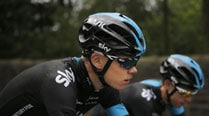 Team Sky and Chris Froome come under fire for their financial might but can’t be faulted for desire. (Source: Reuters)
Team Sky and Chris Froome come under fire for their financial might but can’t be faulted for desire. (Source: Reuters)
Man
WEIGHT LOSS
When Chris Froome turned pro in 2007 at 22, he weighed 167 pounds. At the first Tour de France he won in 2013 he weighed 145 pounds. The 20-pound weight loss increased his ‘power-to-weight ratio’ — a key measurement used to express an athlete’s performance — to about 6.25 w/kg.
LUNG POWER
Froome’s VO2 max — a performance indicator that measures the maximum amount of oxygen an athlete can use — is 88.2. The general population has a VO2 max of 35 to 40, with highly trained individuals in 50s and 60s.
DIET AND TRAINING
Protein reigns supreme, and healthy fats in the off-season teach his body to utilise stored fats for energy. Breakfast is a bowl of porridge and a two-egg omelette while lunch consists of eggs, avocado, and salmon breakfasts, or steak and vegetables lunches. During races he goes back to a higher proportion of carbs. In the gym, focus is on building strength than muscle. Core stability drills, leg strength, and some back work. A lot of squats and lunges, no heavy weights. He also weaves some yoga postures into the stretching.
ALSO READ | Chris Froome and the unpopular invincibles
Machine
HELMET
Froome is wearing the brand new Kask Valegro helmet which comes with 36 vents. The use of advanced materials, as well as brand new moulding techniques has allowed the weight to be significantly dropped while increasing ventilation.
SUIT
In July, Froome and Co were under fire for using a new skinsuit, which features little Vortex air pellets woven into the fabric to smooth the airflow around the body. He ditched the suit in Spain.
BIKE
Froome’s Pinarello Dogma F10 is 6.3 per cent lighter and 7 per cent stiffer than last year’s F8. The downtube design reduces drag by 12.6 per cent. The carbon fibre frame is 60g lighter and provides more tensile strength.
